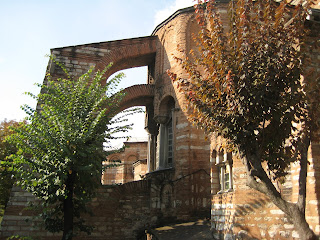Mmmmmm....chocolate mouse.....
OK, I'm back. So after lunch we walked around the Topkapi Palace. The place is huge, and since I can't levitate, I couldn't a picture of a whole thing, but here is a model:
Anyhoo, here is some info from wiki:
he Topkapı Palace ( Topkapı Sarayı) is a palace which was the official and primary residence in the city of Istanbul for the Ottoman Sultans, from 1465 to 1853. The palace was a setting for state occasions and royal entertainments and is a major tourist attraction today. The name directly translates as "Cannongate Palace", from the palace being named after a nearby, now lost gate.
Initial construction started in 1459, ordered by Sultan Mehmed II, the conqueror of Byzantine Constantinople. The palace is a complex made up of four main courtyards and many smaller buildings. At the height of its existence as a royal residence, the palace was home to as many as 4,000 people, formerly covering a larger area with a long shoreline. The complex has been expanded over the centuries, with many renovations such as after the 1509 earthquake and 1665 fire.
Topkapı Palace gradually lost its importance at the end of the 17th century, as the Sultans preferred to spend more time in their new palaces along the Bosporus.
After the end of the Ottoman Empire in 1921, Topkapı Palace was transformed by government decree in 1924 into a museum of the imperial era. The palace is full of examples of Ottoman architecture and also contains large collections of porcelain, robes, weapons, shields, armor, and murals, as well as a display of Ottoman treasure and jewelry.
This is the first courtyard and it is the largest of the three contained within the palace. It served as an outer park.
 At the end of the first courtyard is the Gate of Salutation leading into the second courtyard. It's unknown when it was built, but it is clearly Byzantine rather than Ottoman (listen to me, like I know the difference). I think it looks a little Disney, no?
At the end of the first courtyard is the Gate of Salutation leading into the second courtyard. It's unknown when it was built, but it is clearly Byzantine rather than Ottoman (listen to me, like I know the difference). I think it looks a little Disney, no? This is the entrance to the Royal Treasury, located inside the third courtyard. Inside are amazing jewel encrusted weapons, arms, crowns, necklaces, and other pieces of jewelry. And also the....
This is the entrance to the Royal Treasury, located inside the third courtyard. Inside are amazing jewel encrusted weapons, arms, crowns, necklaces, and other pieces of jewelry. And also the....
Spoonmaker Diamond. It's an 86-carat pear-shaped diamond also known as the Kasikci. Surrounded by a double-row of 49 Old Mine cut diamonds and well spotlighted, it hangs in a glass case on the wall of one of the rooms of the Treasury.
Its origin is not clear. Like many historic diamonds, it is difficult to separate fact from fiction. Rasid, the official historian of the Ottoman court, describes its origin:
The jeweler consulted another jeweler who knew immediately that the pretty stone was really a precious diamond. When the second jeweler threatened to disclose the whole matter, the two men quarreled bitterly. Another jeweler heard the story and bought the diamond, giving a purse full of money to each of the angry jewelers. But now the Grand Vizier, Kopruluzade Ahmed Pasha, has heard of the gem. When Sultan Mehmed IV is told of the affair, he orders the stone be brought to the palace, and he takes possession of it. Whether he paid for it is not revealed. And, of course, no one knows what history preceded it being thrown into the garbage heap."A more probable story is that in 1774 a French officer named Pikot bought the diamond from the Maharajah of Madras in India and then took it to France. Somehow thieves got wind of the gem and robbed Pikot.
Let me just tell you, this thing in real life is HUGE. I saw the Hope Diamond the other day, and that is beautiful (and blue!), but this thing seems twice as big. It looks like one of those huge diamonds in the movies that is too big to really exist, but this one is real!

 Here are some more buildings as you walk around (I won't bore you with the details, this post has gone on quite long enough, don't you think?.
Here are some more buildings as you walk around (I won't bore you with the details, this post has gone on quite long enough, don't you think?.
 The first courtyard also contains the kitchens for the palace. On display are many pieces of china with intricate decorations. They appear so delicate, but at the same time seem durable. I guess they would have to be to last hundreds of years.
The first courtyard also contains the kitchens for the palace. On display are many pieces of china with intricate decorations. They appear so delicate, but at the same time seem durable. I guess they would have to be to last hundreds of years. As you walk out of the first courtyard, there is a stunning view of the Golden Horn and the other side of Istanbul.
As you walk out of the first courtyard, there is a stunning view of the Golden Horn and the other side of Istanbul.As is the usual story, we merely scratched the surface of Topkapi Palace. We could have spent an entire day just there, and there are still tons of outer buildings that we didn't get to, not to mention the interior rooms in the Sultan's and harem's living quarters! But we gotta save some stuff to do next time, right?
Coming up tomorrow: Hagia Sophia!
















































